The long-awaited update to the U.S. OSHA Hazard Communication Standard is finally here. This blog will go through the changes, some issues in the published standard and important items for you to consider when evaluating your materials.
(Text that appears in italics comes directly from the updated OSHA rule.)
Implementation deadline
The question asked most often is regarding the implementation deadline. OSHA opted for a staggered approach, differentiating between substances and mixtures:
(1) Effective date. This section shall become effective July 19, 2024.
(2) Substances.
(i) Manufacturers, importers, and distributors, evaluating substances shall be in compliance with all modified provisions of this section no later than January 19, 2026.
(ii) For substances, all employers shall, as necessary, update any alternative workplace labeling used under paragraph (f)(6) of this section, update the hazard communication program required by paragraph (h)(1) of this section, and provide any additional employee training in accordance with paragraph (h)(3) of this section for newly identified physical hazard, or health hazards or other hazards covered under this section no later than July 20, 2026.
(3) Mixtures.
(i) Chemical manufacturers, importers, and distributors evaluating mixtures shall be in compliance with all modified provisions of this section no later than July 19, 2027.
(ii) For mixtures, all employers shall, as necessary, update any alternative workplace labeling used under paragraph (f)(6) of this section, update the hazard communication program required by paragraph (h)(1) of this section, and provide any additional employee training in accordance with paragraph (h)(3) of this section for newly identified physical hazards, health hazards, or other hazards covered under this section no later than January 19, 2028.
(4) Compliance. Between May 20, 2024, and the dates specified in paragraphs (j)(2) and (3) of this section, as applicable, chemical manufacturers, importers, distributors, and employers may comply with either this section or § 1910.1200 revised as of July 1, 2023, or both during the transition period.
U.N. GHS version update
The update mainly implements the 7th revision of U.N. GHS. However, OSHA did include some updates from revision 8. This does help to keep the U.S. and Canada aligned, but it could make the implementation of this a little more complex. Furthermore, the commentary associated with the regulation is interesting and useful in understanding OSHA’s reasoning for the update along with the rebuttal to concerns raised in the draft document.
Definitions
A couple of new definitions have been added for bulk shipment and combustible dust.
Bulk shipment means any hazardous chemical transported where the mode of transportation comprises the immediate container (i.e., contained in tanker truck, rail car, or intermodal container).
Combustible dust means finely divided solid particulates of a substance or mixture that pose a flash-fire hazard or explosion hazard when dispersed in air or other oxidizing media.
Regarding bulk shipment, there were comments recommending that this match the definition implemented under U.S. DOT. OSHA did not take this recommendation, as they intended to use this definition as an exception in (f)(5)(ii) for shipments that do not have immediate forms of packaging. This difference is noted here to create awareness that the term will need to be used in the context of the regulation it is being applied to.
Combustible dust was not defined in the previous version of the standard, as OSHA had intended to implement this separately. OSHA had originally planned to implement the U.N. version of the definition, however there were many questions around the terminology being used, so the definition was changed to be more specific about the hazards involved.
Hazard classification
An update was made to paragraph (d)(1) to clarify what should be considered when classifying a material. The Federal Register contains the following update:
(d)(1)
(i) Chemical manufacturers and importers shall evaluate chemicals produced in their workplaces or imported by them to classify the chemicals in accordance with this section. For each chemical, the chemical manufacturer or importer shall determine the hazard classes, and where appropriate, the category of each class that apply to the chemical being classified. The hazard classification shall include any hazards associated with the chemical’s intrinsic properties including:
(A) A change in the chemical’s physical form and;
(B) chemical reaction products associated with known or reasonably anticipated uses or applications.
(ii) Employers are not required to classify chemicals unless they choose not to rely on the classification performed by the chemical manufacturer or importer for the chemical to satisfy this paragraph (d)(1).
OSHA stated that this was not meant to be a new requirement, but rather clarification of paragraph (b)(2), which states:
This section applies to any chemical which is known to be present in the workplace in such a manner that employees may be exposed under normal conditions of use or in a foreseeable emergency.
The commentary contained many discussion points around what this means and when a chemical reaction would need to be considered. OSHA was clear that they did not imply that that all possible chemical reactions should be considered. They gave the example of toluene, where it would not be possible to document all possible reactions that could occur. They were specific about it applying to anticipated uses. The examples they gave here indicated that they were talking about items such as kits where the hazards of the mixed kit ingredients might be different than those of the individual kit components. Other examples were specific use cases, such as hair straighteners giving off formaldehyde when exposed to heat. It will be important to keep these examples in mind when evaluating your own materials to determine the hazards associated with it.
In addition, OSHA specified that these types of hazards—those associated with a chemical reaction—were not required to be on the label. This is clearly stated in the commentary, but there does seem to be an error in the text of the Federal Register. Based on the context and examples given in the commentary sub-paragraphs, (A) and (B) (excerpted above) should have been (i) and (ii). Note that this was corrected in the red-lined version of the standard.
Below is the text in the standard for both the SDS and label:
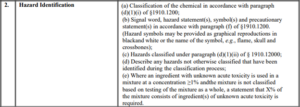
From everything shared above, we can see that it was not OSHA’s intention to include hazards associated with “chemical reaction products associated with known or reasonably anticipated uses or applications” as a part of the “main” classification of the product. In addition, based on where it is placed in the SDS format, along with the fact that this should not be added to the label, it is understood that no label elements (signal words, hazard statements, precautionary statements and symbols) are required for hazards associated with (d)(1)(ii).
For reference, below is an excerpt showing the label requirements:
(f) * * *
1. Labels on shipped containers. The chemical manufacturer, importer, or distributor shall ensure that each container of hazardous chemicals leaving the workplace is labeled, tagged or marked. Hazards not otherwise classified and hazards identified and classified under (d)(1)(ii) do not have to be addressed on the container. Where the chemical manufacturer, importer, or distributor is required to label, tag or mark the following shall be provided:
(I) Product identifier;
(ii) Signal word;
(iii) Hazard statement(s);
(iv) Pictogram(s);
(v) Precautionary statement(s);
(vi) Name, U.S. address, and U.S. telephone number of the chemical manufacturer, importer, or other responsible party.
Acute toxicity
OSHA added additional text to this section to address hazards associated with respiratory tract corrosion:
A.1.2.4.1 If the classifier determines the chemical is corrosive to the respiratory tract and data are available that indicate that the effect leads to lethality, then in addition to the appropriate acute toxicity pictogram and hazard statement, the chemical must be labelled with the hazard statement “corrosive to the respiratory tract” and the corrosive pictogram.
A.1.2.4.2 If the classifier determines the chemical is corrosive to the respiratory tract and the effect does not lead to lethality, then the chemical must be addressed in the Specific Target Organ Toxicity hazard classes (see A.8). If data is insufficient for classification under STOT, but the classifier determines, based on skin or eye data, that the chemical may be corrosive to the respiratory tract, then the hazard must be addressed using data for classification in the skin corrosion/irritation hazard class (see A.2) or Serious Eye Damage/Eye irritation hazard class (see A.3).
Respiratory tract corrosion can be classified in one of three different ways depending on the severity of the hazards. However, in all cases a hazard statement regarding respiratory tract corrosion and the corrosive pictogram should be shown. (See notes beneath the tables below.)
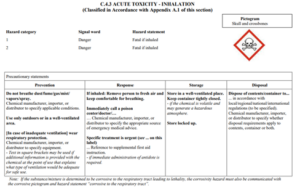
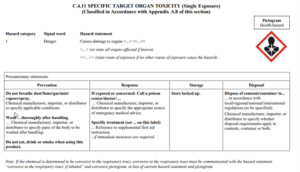
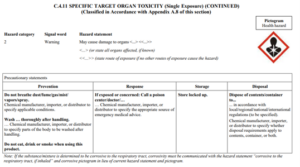
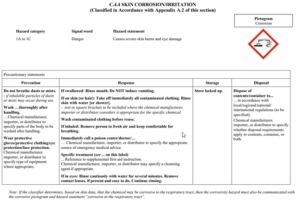
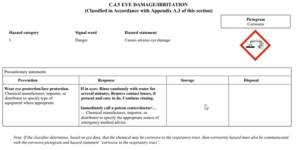
Skin corrosion irritation
This section was rewritten to better explain the tiered method of classification:
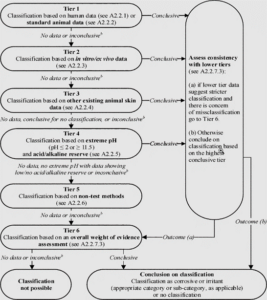
Serious eye damage/eye irritation
As with skin, a tiered method for classification has also been applied here:
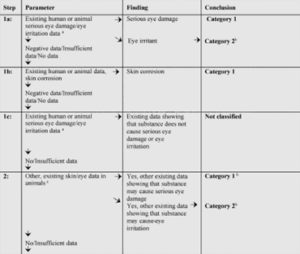

Reproductive toxicity
Table A.7.1 has been updated to the following:
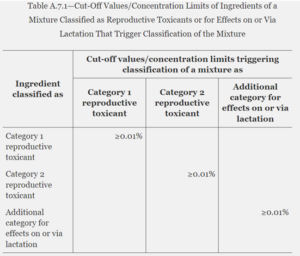
This is a significant change from the previous version:

As there was no mention of this in the commentary, and it would cause a deviation from the U.N. GHS, it could be that this is an error in the text. We will need to wait and see whether OSHA comments on this.
STOT – SE
Clarification was added to address how the classification should be done when the additive approach is used when classifying for category 3. This included information on the cutoff to which an ingredient would be considered relevant.
The classification rules used for mixtures based on ingredient information were revised for clarity and to implement a relevant ingredient threshold to be used with the additivity calculation.
Flammable gases
The flammable gases section has been updated to be in line with U.N. GHS. This includes adding the pyrophoric gas classification, as opposed to OSHA’s initial implementation, which had it as its own separate hazard. In addition to adding the pyrophoric gases, chemically unstable gases have been added with the expansion of Category 1 to include the subcategories.
Aerosols
Flammable aerosols have been changed to Aerosols and category 3 has been implemented along with additional information on how to classify. Many of the classification chapters have been updated along with this to state that the aerosol classification is not required to be added in addition to the other hazard. This includes flammable liquids, flammable solids and gases under pressure.
Chemicals under pressure
This hazard class is in U.N. GHS revision 8 and was also implemented by Canada in their recent GHS update.
Self-heating chemicals
The section on self-heating chemicals was updated with the following text:
Classification of solid chemicals shall be based on tests performed on the chemical as presented. If, for example, for the purposes of supply or transport, the same chemical is to be presented in a physical form different from that which was tested and which is considered likely to materially alter its performance in a classification test, classification must be based on testing of the chemical in the new form.
This is consistent with the clarification of what should be considered for classification. OSHA is looking for a complete evaluation of the hazards associated with all the forms of the material that could be encountered.
Desensitized explosives
This is another new hazard class that was added to align with the U.N. GHS.
SDS and label changes
The draft included a proposal to require the date that a material was released for shipment on the label. Based on the feedback, OSHA has decided to remove this proposal and it is not in the final publication.
OSHA did decide to address small container labeling in this update. The language is as follows:
(12) Small container labelling. (i) This paragraph applies where the chemical manufacturer, importer, or distributor can demonstrate that it is not feasible to use pull-out labels, fold-back labels, or tags containing the full label information required by paragraph (f)(1) of this section.
(ii) For a container less than or equal to 100 ml capacity, the chemical manufacturer, importer, or distributor must include, at a minimum, the following information on the label of the container:
(A) Product identifier;
(B) Pictogram(s);
(C) Signal word;
(D) Chemical manufacturer’s name and phone number; and
(E) A statement that the full label information for the hazardous chemical is provided on the immediate outer package.
(iii) For a container less than or equal to 3 ml capacity, where the chemical manufacturer, importer, or distributor can demonstrate that any label interferes with the normal use of the container, no label is required, but the container must bear, at a minimum, the product identifier.
(iv) For all small containers covered by paragraph (f)(12)(ii) or (iii) of this section, the immediate outer package must include:
(A) The full label information required by paragraph (f)(1) of this section for each hazardous chemical in the immediate outer package. The label must not be removed or defaced, as required by paragraph (f)(9) of this section.
(B) A statement that the small container(s) inside must be stored in the immediate outer package bearing the complete label when not in use.
Pictograms were updated to incorporate the new hazards. In addition, the exclamation mark can now be added when there is an HNOC associated with the material. When it is used it must have the words “Hazards not otherwise classified” or “HNOC” below the pictogram. Along with the update to pictograms, hazard and precautionary statements have also been updated.
The trade secret section was updated to include prescribed concentration ranges. These match the ranges implemented by Canada. In responding to criticisms of this, OSHA did add paragraph (vi) where it states that manufacturers may provide a narrower range than those prescribed. The reason for this is that OSHA has the expectation that the top end of the range given in Section 3 will match the classification being given in Section 2. This could be difficult to determine unless a company decides to classify based on that top range, which could be higher than the actual concentration. This is especially true when it comes to substances with multiple classifications or those with additive hazards. In addition, classifying at the top end of the range may overclassify your materials if the top end of the range is not close to the actual value.
Lastly, there were some changes made to the format of the SDS, for example:
- Section 3 added a new section, as previously reviewed in this post.
- Section 9 reordered and added new characteristics.
- Section 11 added interactive effects.
- Section 14 renamed bulk transport header.
The update to the Hazard Communication Standard has been a long one, and it is interesting to see what changed between the draft and the final, along with OSHA’s reasoning. However, the clock is now ticking and while the broad strokes are clear, it is now time to get into the details. That is where the hard work starts. Stay tuned as we work through those details and continue to update you on what we learn.
The information provided in this blog is for general information purposes only, may not be updated in real time and does not constitute legal advice. Please consult with your legal and other advisors to discuss your particular needs and circumstances.

















